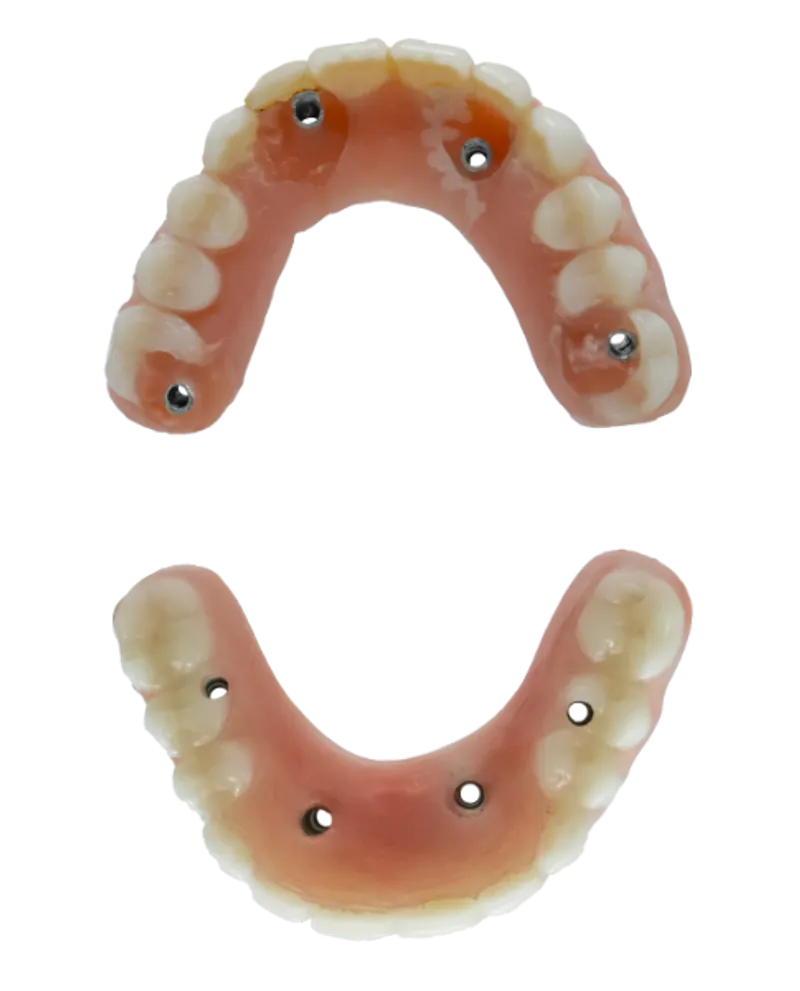All-on-X Failures: Why They Happen—and How to Avoid Them

Contents
Introduction
Most All-on-X cases succeed, with modern studies showing high 5-year survival when treatment is planned and maintained well. Still, failures do happen. The good news? The biggest risks are both knowable and preventable with the right plan, team, and home care.
"All-on-X" is a fixed full-arch bridge (a new set of teeth) anchored to X implants—often 4 to 6—placed strategically in your jaw. The implants act like new tooth roots; the bridge stays in and doesn't come out at home.
Related Reading: Compare All-on-X with other options in our complete decision guide , or learn about the journey from dentures to modern implants
The 5 Big Buckets of Failure
-
1) Biological Causes
Peri-implantitis (infection/inflammation around implants). A history of gum disease, poor plaque control, and skipping maintenance visits all raise risk.
Untreated gum disease elsewhere can “seed” implant sites with harmful bacteria. Regular supportive care lowers the chance of peri-implantitis developing.
Prevention: professional cleanings on a set recall schedule, daily implant-safe hygiene at home, and early treatment if the gums bleed or feel tender. (See Maintenance below.)
-
2) Patient health & habits
Smoking. Meta-analysis: implants in smokers have ~140% higher failure risk than in non-smokers. Quitting before and after surgery improves outcomes. Learn about alternative implant options that may be more suitable for smokers.
Diabetes. Poorly controlled blood sugar is linked to more peri-implant problems; well-controlled diabetes can have outcomes comparable to non-diabetics.
Certain bone medications (antiresorptives/bisphosphonates). Some studies show higher implant failure or jawbone complications in specific scenarios; high-dose IV therapy warrants special caution and coordination with your physician.
Bruxism (clenching/grinding). Bruxers carry a higher implant-failure risk; bite protection is key.
Dental Hygiene. Improper cleaning, brushing, and flossing can cause bacteria to build up leading to other issues. Like natural teeth, cleaning and removing plaque is key.
-
3) Mechanical/engineering issues
Occlusal overload (too much force on too few/poorly positioned implants). Overload is linked to bone loss and implant complications.
Excess cantilevers and poor anterior-posterior (AP) spread. Long “overhangs” beyond the rearmost implant concentrate stress; designing the bridge with adequate AP spread keeps forces safer.
Prevention: Use enough implants for your bone and bite (sometimes 5–6 instead of 4), aim for robust AP spread, minimize cantilevers, and fine-tune the bite.
-
4) Surgical/planning problems
Poor implant position/angulation or placement without precise guides can compromise strength and cleanability.
Insufficient bone volume/density not addressed with grafting or altered plans can jeopardize stability. Modern protocols use 3D planning and guided surgery to translate a digital plan into accurate, repeatable placement—supporting better esthetics and engineering.
Prevention: CBCT-based planning, surgical guides, and a team approach (surgeon + restorative dentist/prosthodontist + lab) to design both the prosthesis and the anatomy as a single system.
-
5) Maintenance & aftercare gaps
A higher prevalence of peri-implantitis can occur without daily home care and regular professional maintenance. A written maintenance plan, hygiene coaching, and scheduled recalls with X-rays to check bone levels. Professional organizations emphasize twice-daily brushing, interdental cleaning, and water-irrigation as helpful adjuncts for full-arch patients
What to Expect at Smileloc to Reduce Risk
-
Thorough candidacy check We review health history (smoking, diabetes, meds) and gum status to reduce biological risks before we begin.
-
3D planning & guided surgery We design implant positions around your bone and bite, targeting strong AP spread and short cantilevers.
-
The right “X.” Not everyone should get four implants; in softer bone or heavy bites, adding support (All-on-5/6) can lower overload. We cater your process to you.
-
Same-day teeth—when stability says yes. Immediate loading shows high survival when primary stability is adequate, but we individualize timing if your bone needs more healing.
-
Smileloc over screws or cement Smileloc's arches can be unlocked without ruining the arch leading to quicker maintenance visits and easier cleaning.
-
Maintenance mapped out. You’ll leave with simple home-care steps and a recall schedule to protect your investment.